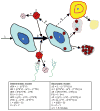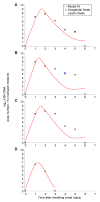Frequent release of low amounts of herpes simplex virus from neurons: results of a mathematical model
- PMID: 20161655
- PMCID: PMC2818652
- DOI: 10.1126/scitranslmed.3000193
Frequent release of low amounts of herpes simplex virus from neurons: results of a mathematical model
Abstract
Herpes simplex virus-2 (HSV-2) is a sexually transmitted infection that is the leading cause of genital ulcers worldwide. Infection is life long and is characterized by repeated asymptomatic and symptomatic shedding episodes of virus that are initiated when virus is released from neurons into the genital tract. The pattern of HSV-2 release from neurons into the genital tract is poorly understood. We fit a mathematical model of HSV-2 pathogenesis to curves generated from daily quantification of HSV in mucosal swabs performed from patients with herpetic genital ulcers. We used virologic parameters derived from model fitting for stochastic model simulations. These simulations reproduced previously documented estimates for shedding frequency, and herpetic lesion diameter and frequency. The most realistic model output occurred when we assumed minimal amounts of daily neuronal virus introduction. In our simulations, small changes in average total quantity of HSV-2 released from neurons influenced detectable shedding frequency, while changes in frequency of neuronal HSV-2 release had little effect. Frequent HSV-2 shedding episodes in humans are explained by nearly constant release of small numbers of viruses from neurons that terminate in the genital tract.
Conflict of interest statement
Competing interests: The authors declare that they have no competing financial interests.
Figures




Similar articles
-
Reactivation of genital herpes simplex virus type 2 infection in asymptomatic seropositive persons.N Engl J Med. 2000 Mar 23;342(12):844-50. doi: 10.1056/NEJM200003233421203. N Engl J Med. 2000. PMID: 10727588
-
Genital shedding of herpes simplex virus among symptomatic and asymptomatic persons with HSV-2 infection.JAMA. 2011 Apr 13;305(14):1441-9. doi: 10.1001/jama.2011.420. JAMA. 2011. PMID: 21486977 Free PMC article.
-
Virologic and immunologic evidence of multifocal genital herpes simplex virus 2 infection.J Virol. 2014 May;88(9):4921-31. doi: 10.1128/JVI.03285-13. Epub 2014 Feb 19. J Virol. 2014. PMID: 24554666 Free PMC article.
-
Current Concepts for Genital Herpes Simplex Virus Infection: Diagnostics and Pathogenesis of Genital Tract Shedding.Clin Microbiol Rev. 2016 Jan;29(1):149-61. doi: 10.1128/CMR.00043-15. Clin Microbiol Rev. 2016. PMID: 26561565 Free PMC article. Review.
-
Herpes simplex virus: the importance of asymptomatic shedding.J Antimicrob Chemother. 2000 Apr;45 Suppl T3:1-8. doi: 10.1093/jac/45.suppl_4.1. J Antimicrob Chemother. 2000. PMID: 10855766 Review.
Cited by
-
Advances in Parameter Estimation and Learning from Data for Mathematical Models of Hepatitis C Viral Kinetics.Mathematics (Basel). 2022 Jun 2;10(12):2136. doi: 10.3390/math10122136. Epub 2022 Jun 19. Mathematics (Basel). 2022. PMID: 36245949 Free PMC article.
-
A Parameter Estimation Method for Multiscale Models of Hepatitis C Virus Dynamics.Bull Math Biol. 2019 Oct;81(10):3675-3721. doi: 10.1007/s11538-019-00644-7. Epub 2019 Jul 23. Bull Math Biol. 2019. PMID: 31338739 Free PMC article.
-
Detailed analysis of mucosal herpes simplex virus-2 replication kinetics with and without antiviral therapy.J Antimicrob Chemother. 2011 Nov;66(11):2593-600. doi: 10.1093/jac/dkr346. Epub 2011 Aug 24. J Antimicrob Chemother. 2011. PMID: 21865349 Free PMC article.
-
Solving Immunology?Trends Immunol. 2017 Feb;38(2):116-127. doi: 10.1016/j.it.2016.11.006. Epub 2016 Dec 13. Trends Immunol. 2017. PMID: 27986392 Free PMC article. Review.
-
Vaccines against Genital Herpes: Where Are We?Vaccines (Basel). 2020 Jul 27;8(3):420. doi: 10.3390/vaccines8030420. Vaccines (Basel). 2020. PMID: 32727077 Free PMC article. Review.
References
-
- Weiss H. Epidemiology of herpes simplex virus type 2 infection in the developing world. Herpes. 2004;11(Suppl 1):24A. - PubMed
-
- Freeman E, et al. Herpes simplex virus 2 infection increases HIV acquisition in men and women: systematic review and meta-analysis of longitudinal studies. AIDS. 2006;20:73. - PubMed
-
- Gray R, et al. Probability of HIV-1 transmission per coital act in monogamous, heterosexual, HIV-1-discordant couples in Rakai, Uganda. Lancet. 2001;357:1149. - PubMed
-
- Stanberry LR, Kern ER, Richards JT, Abbott TM, Overall JC., Jr Genital herpes in guinea pigs: pathogenesis of the primary infection and description of recurrent disease. J Infect Dis. 1982;146:397. - PubMed
Publication types
MeSH terms
Grants and funding
LinkOut - more resources
Full Text Sources
Other Literature Sources

